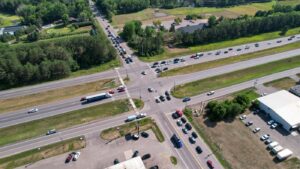
UPDATE: Goldman Sachs has issued an urgent warning about a potential era of “jobless growth” in the United States fueled by the rapid rise of artificial intelligence (AI). In a revealing note released on September 25, 2023, analysts highlighted that while the US economy shows strong productivity gains, job creation is lagging, raising significant concerns for the workforce.
The report states that AI is like a “tsunami” that could split the economy, leaving behind those unable to adapt. As companies increasingly focus on AI to cut labor costs, job growth outside the healthcare sector has already turned negative in recent months. In September alone, the private sector reportedly lost 32,000 jobs, according to ADP data.
The implications are profound. As productivity soars, workers may find themselves squeezed, with companies prioritizing efficiency over hiring. Goldman Sachs analysts noted, “The modest job growth alongside robust GDP growth seen recently is likely to be normal to some degree in the years ahead.” This trend, driven largely by AI, threatens to erode traditional employment opportunities.
Evidence of a weaker job market is already emerging. Hiring plans are at their lowest level since the Great Recession, as reported by Challenger, Gray & Christmas. Furthermore, workforce analytics firm Revelio Labs indicated a staggering 17.2% drop in job openings compared to a year ago.
The analysts acknowledge that fears of technology displacing workers are not new; however, they emphasize that the impact of AI may soon become starkly apparent. “Over just the last few years, AI does appear to be hurting the employment prospects of the most closely exposed workers, such as young technology workers,” they commented.
Amid these troubling trends, Goldman Sachs points out a potential silver lining: rapid productivity growth could help keep inflation in check. This might provide the Federal Reserve with more flexibility in monetary policy, allowing for potential interest rate cuts even if unemployment rises.
Looking to the future, the analysts caution that the true test of the AI economy may arise during the next economic downturn. Historically, routine occupations have faced significant job losses following productivity booms, a phenomenon evident during the early-2000s “jobless recovery.” Companies often seize these downturns to restructure, prioritizing efficiency and further cutting jobs in less productive areas.
Moreover, the analysts warn that AI could exacerbate economic inequality, rewarding workers who can leverage new technologies while displacing mid-level jobs. This “hollowing out” of the middle class mirrors past disruptions seen in blue-collar sectors due to automation.
As the US grapples with these challenges, the urgency for workers to adapt has never been greater. Goldman Sachs’ report serves as a critical reminder of the fast-evolving landscape shaped by AI and its potential to alter the job market irreversibly.
The ongoing developments in AI’s impact on employment will be crucial to monitor. For those in the workforce, the time to adapt is now—failure to do so could mean being left behind in an economy that demands new skills and innovation.
Stay tuned for more updates as this story unfolds.







